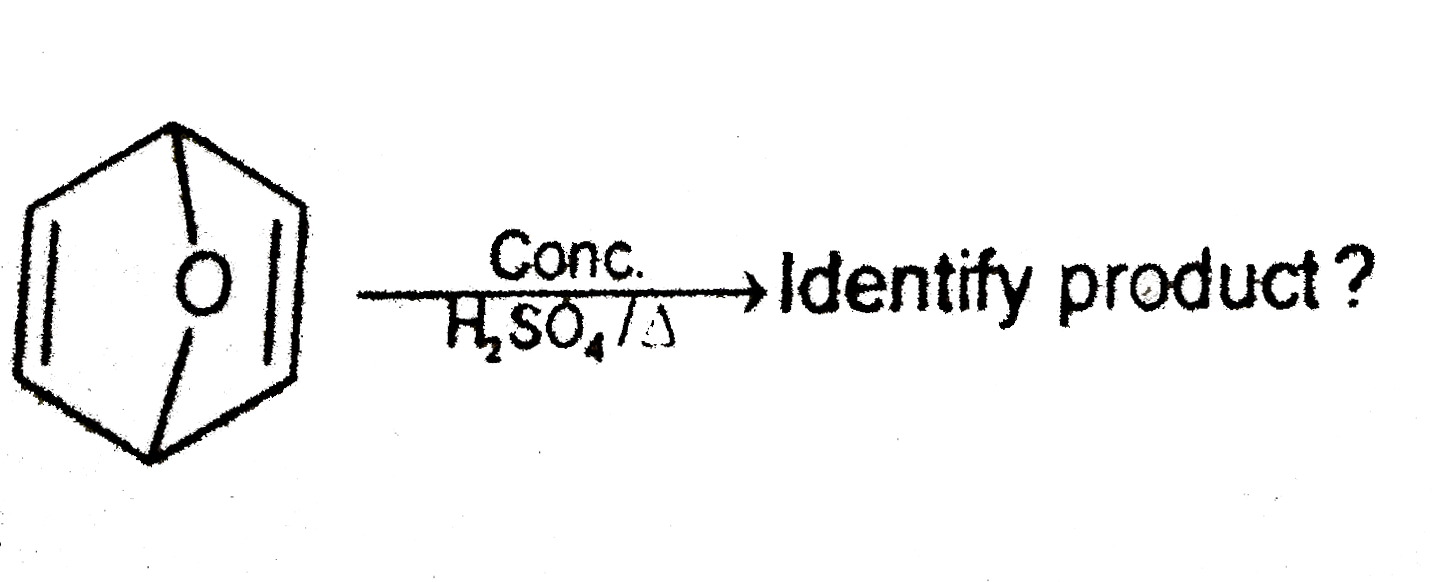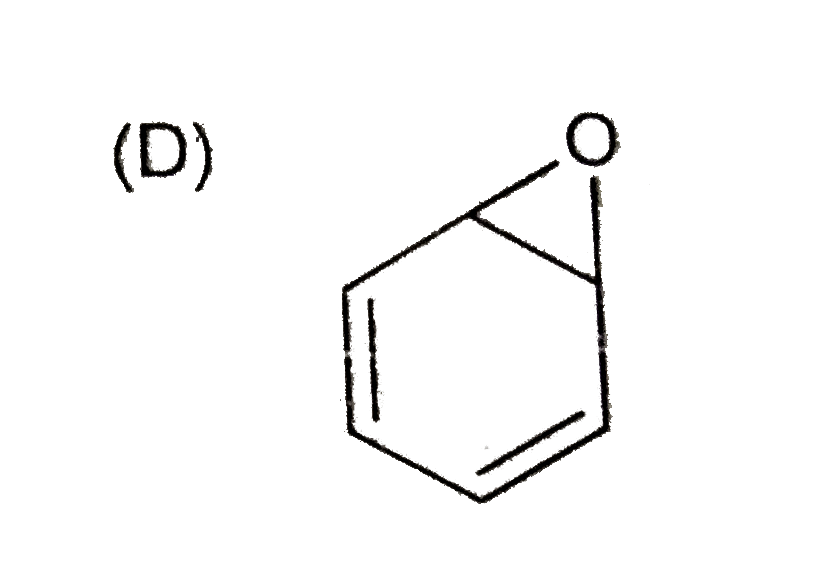Predict the products of the following reactions :
(i)Toluene (i)Alk.KMnO4,Δ−−−−−−−−−−−−→
(ii) Nitrobenzene Conc.HNO3−−−−−−−−−→+Conc.H2SO4
(iii)Ethylbenzene + acetic anhydride −−−−−−−→Anhyd.AlCl3
To predict the products of the given reactions, we will analyze each reaction step by step.
Reaction (i): Toluene (i)Alk.KMnO4,Δ−−−−−−−−−−−−→
1. Identify the Reactant: The reactant is toluene (C6H5CH3), which is an aromatic hydrocarbon with a methyl group attached to the benzene ring.
2. Reagent and Conditions: The reagent is alkaline potassium permanganate (KMnO4) under heating conditions (Δ). KMnO4 is a strong oxidizing agent.
3. Reaction Mechanism: The oxidizing agent will oxidize the methyl group (-CH3) of toluene to a carboxylic acid (-COOH) group. The reaction will convert the methyl group into a carboxylic acid while leaving the benzene ring intact.
4. Product Formation: The product of this reaction will be benzoic acid (C6H5COOH).
Final Product: Benzoic acid (C6H5COOH)
---
Reaction (ii): Nitrobenzene Conc.HNO3−−−−−−−−−−−−→(+Conc.H2SO4)
1. Identify the Reactant: The reactant is nitrobenzene (C6H5NO2), which has a nitro group (-NO2) attached to the benzene ring.
2. Reagents and Conditions: The reagents are concentrated sulfuric acid (H2SO4) and concentrated nitric acid (HNO3). This combination is known as a nitrating mixture.
3. Reaction Mechanism: The nitro group is a deactivating group and directs further electrophilic substitution to the meta position. The electrophile generated in this reaction is the nitronium ion (NO2+).
4. Product Formation: The major product will be meta-nitrotoluene (C6H4(NO2)2) since the nitro group directs substitution to the meta position.
Final Product: Meta-nitrotoluene (C6H4(NO2)2)
---
Reaction (iii): Ethylbenzene + Acetic Anhydride −−−−−−−−−→(Anhyd.AlCl3)
1. Identify the Reactants: The reactants are ethylbenzene (C6H5C2H5) and acetic anhydride ((CH3CO)2O).
2. Reagent and Conditions: The reagent is anhydrous aluminum chloride (AlCl3), which acts as a Lewis acid catalyst.
3. Reaction Mechanism: In this Friedel-Crafts acylation reaction, acetic anhydride will react with ethylbenzene. The aluminum chloride will generate the acylium ion (CH3CO+), which will act as the electrophile.
4. Product Formation: The product will be acetophenone (C6H5COCH3), where the acyl group (from acetic anhydride) is added to the benzene ring.
Final Product: Acetophenone (C6H5COCH3)
---
Summary of Products:
1. Toluene + Alk. KMnO4 → Benzoic acid (C6H5COOH)
2. Nitrobenzene + Conc. H2SO4 + Conc. HNO3 → Meta-nitrotoluene (C6H4(NO2)2)
3. Ethylbenzene + Acetic Anhydride + Anhyd. AlCl3 → Acetophenone (C6H5COCH3)
---
2. Reagent and Conditions: The reagent is alkaline potassium permanganate (KMnO4) under heating conditions (Δ). KMnO4 is a strong oxidizing agent.
1. Toluene + Alk. KMnO4 → Benzoic acid (C6H5COOH)
2. Nitrobenzene + Conc. H2SO4 + Conc. HNO3 → Meta-nitrotoluene (C6H4(NO2)2)
3. Ethylbenzene + Acetic Anhydride + Anhyd. AlCl3 → Acetophenone (C6H5COCH3)
Topper's Solved these Questions
- HYDROCARBONSBOOK - PRADEEPCHAPTER - HYDROCARBONSEXERCISE - ADDITIONAL QUESTIONS (LONG ANSWER QUESTIONS)
11 Videos
- HYDROCARBONSBOOK - PRADEEPCHAPTER - HYDROCARBONSEXERCISE - ANALYTICAL QUESTIONS AND PROBLEMS WITH ANSWERS/SOLUTIONS (QUESTIONS)
16 Videos
- HYDROCARBONSBOOK - PRADEEPCHAPTER - HYDROCARBONSEXERCISE - ADDITIONAL QUESTIONS (VERY SHORT ANSWER TYPE QUESTIONS )
30 Videos
- EQUILIBRIUM IN PHYSICAL AND CHEMICAL PROCESSESBOOK - PRADEEPCHAPTER - EQUILIBRIUM IN PHYSICAL AND CHEMICAL PROCESSESEXERCISE - Competition Focus (Jee(Main and advanced)/Medical Entrance) VIII. ASSERTION - REASON TYPE QUESTIONS (TYPE - II)
10 Videos
- HYDROGEN BOOK - PRADEEPCHAPTER - HYDROGEN EXERCISE - COMPETITION FOCUS (Assertion-Reason Type Questions) Type 2
15 Videos
Similar Questions
Knowledge Check
C6H5OHconc.HNO3−−−−−−→H2SO4X. X is ___________
ABenzeneBCatecholConly p-NitrophenolD2,4,6-Trinitrophenol Conc.−−−−−−→H2SO4/Δ identify product?A
Conc.−−−−−−→H2SO4/Δ identify product?A B
B C
C D
D
The major product of the following reaction
 (1)tBuOK−−−−−−−−−−−−→(2)Conc.H2SO4/ΔA
(1)tBuOK−−−−−−−−−−−−→(2)Conc.H2SO4/ΔA B
B C
C D
D
 underset (Conc. H_(2)SO_(4))overset(Conc. HNO_(3))toP underset(Delta)overset(Sn, Conc. HCl)toQ
underset (Conc. H_(2)SO_(4))overset(Conc. HNO_(3))toP underset(Delta)overset(Sn, Conc. HCl)toQ
The product Q is :
View SolutionIn the following sequence of reactions:
Toluene KMnO4−−−−→ASOCl2−−−→BH2Pd−−−→BaSO4C
the product C is
View SolutionThe end product in the following reaction is,PhClH2O+CuCl2−−−−−−−→Aconc.HNO3−−−−−−→B
View Solution i.AlCl3−−−−→ii.H2O
i.AlCl3−−−−→ii.H2O
View SolutionPredict the product (B) in the following sequence of reactions:
Ethylbenzene KMnO4−KOH−−−−−−−−−→ΔAH3O+−−−→B
View Solution
